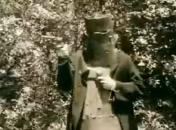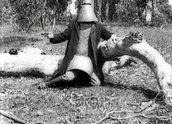AustLit
Latest Issues
AbstractHistoryArchive Description
'The picture is an exceedingly interesting one right from the opening scene, where Constable Fitzpatrick arrives with a warrant for the arrest of Dan Kelly, then to the police camp, which is captured by the Kellys, the sticking-up of Younghusband's station, robbing the bank at Euroa, destroying the railway line, and finally to the capture of Ned Kelly in his suit of armour.'
[Source: 'The Story of the Kelly Gang', The Register, 29 December 1906, p.4.]
Notes
-
At over an hour long, this Australian-made production is thought to be the world’s first feature-length narrative movie (Sally Jackson and Graham Shirley, 2006).
-
The Story of the Kelly Gang (1906) is inscribed on the UNESCO Australian Memory of the World Register.
Publication Details of Only Known VersionEarliest 2 Known Versions of
Works about this Work
-
The Story of the Kelly Gang
2022
single work
essay
— Appears in: Melbourne on Film : Cinema That Defines Our City 2022; -
The Larrikin Girl : Challenging Archetypes in Australian Cinema
2022
single work
criticism
— Appears in: Senses of Cinema , October no. 103 2022;'Australian cinema has travelled a varied trajectory since its initial development in the late 19th century. The cinema reflected the developing social and cultural tropes of its time, as the concept of a distinct Australian identity began to form. But it is clear that a colonial history of Australian film focuses very clearly and emphatically along lines of class and gender. Rose Lucas notes that there is a “cluster of dominant, recognisable images in our cinema” which consists of the bushman, the ocker, the ‘mate’, and the ‘battler’, a series of male coded tropes which are stubbornly pervasive within this national cinema. These archetypes have trained a concentrated gaze upon masculinity in Australian cinema, but there has been little space in this cultural landscape for the development of archetypical women in Australia’s cultural history with very few valued traits that are specifically coded female. This resolutely masculine perspective seems to have shaped the nation and the national cinema, and Lucas’s observation highlights the key archetypes as embodied as masculine. But these archetypes, long the sole domain of masculine representation, also have historically encompassed female experiences. In this paper we identify the need to broaden such a framework, and by taking the most Australian and most masculine of forms – the larrikin – we argue that the larrikin girl has been hiding in plain sight across Australian film history.' (Introduction)
-
The Story of the Kelly Gang 1906
i
"From a fallen tree, all",
2020
single work
poetry
— Appears in: In Your Hands 2020; (p. 89) -
Dead Heart : Australia’s Horror Cinema
2018
single work
column
— Appears in: FilmInk , 31 October 2018; -
Introduction : Screening Melbourne
2017
single work
essay
— Appears in: Senses of Cinema , December no. 85 2017;
-
The Story of the Kelly Gang Rewatched – The World's First Feature-length Film
2016
single work
review
— Appears in: The Guardian Australia , 6 March 2016;
— Review of The Story of the Kelly Gang 1906 single work film/TV -
Ned's Stolen Moment in the Spotlight Completely Covered
2006
single work
column
— Appears in: The Canberra Times , 25 November 2006; -
Your Job is to Amaze Me
2011
single work
criticism
— Appears in: Griffith Review , [Autumn] no. 31 2011; -
More Australian than Aristotelian : The Australian Bushranger Film, 1904-1914
2002
single work
criticism
— Appears in: Senses of Cinema , January-February no. 18 2002;This analysis of The Story of the Kelly Gang, Thunderbolt, and The Squatter's Daughter considers early Australian films in the light of American cowboy films, arguing that 'it is the contention of this paper that these relations are the result of certain cultural coincidences between Australia and the Western United States rather than the outcome of direct influence of the one upon the other. Viewed in this light, “the American cinema par excellence” can perhaps be more reasonably understood as the epitome of a global cinema – not an original myth of nationhood, but a story of no-place retold everywhere and at all times, even in terra nullius itself.'
-
Marvellous Melbourne : Queen City of the South
2011
single work
criticism
— Appears in: Senses of Cinema , 23 June no. 59 2011; -
Poetry as Cinema : A Discursive Screening from 1913-2006
2011
single work
criticism
— Appears in: Southerly , vol. 71 no. 3 2011; (p. 135-148) 'Australian cinema began with a confident leap into the future. Charles Tait's The Story of the Kelly Gang, made in Melbourne in 1906, is credited as the world's first narrative feature. Post-Federation years continued to see poetry influence the national imagination, and occasionally inspire cinema on its journey.' (Author's abstract)





